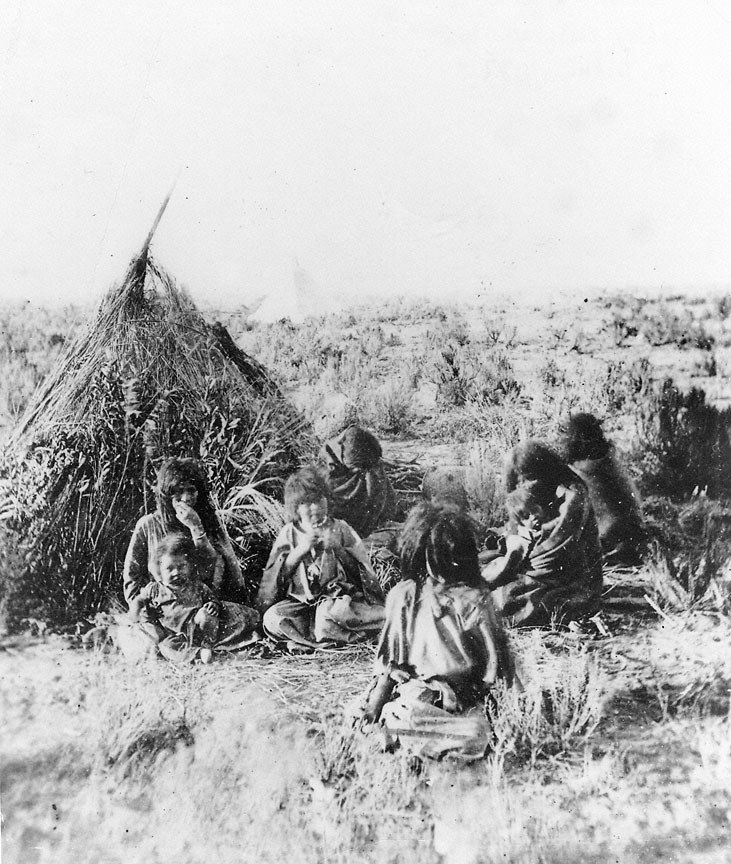- Catalog No. —
- OrHi 45440
- Date —
- 1872
- Era —
- 1846-1880 (Treaties, Civil War, and Immigration)
- Themes —
- Archaeology and Anthropology, Native Americans, Oregon Trail and Resettlement
- Credits —
- Oregon Historical Society
- Regions —
- Southeast
- Author —
- William H. Jackson
Family of Bannock Indians, 1872
This photograph shows a family of Indians, identified by the photographer as Bannocks, sitting in front of a small pole-and-thatch lodge. It was taken in Idaho Territory in 1872 by William H. Jackson, a pioneer western photographer best known for his photographs of Yellowstone.
The Bannock speak a dialect of Northern Paiute, part of the Numic language family, and are closely related to the Northern Paiute peoples of southeastern Oregon, Nevada, and eastern California. Anthropologists believe that the Bannock may have migrated from southeastern Oregon to Idaho’s Snake River Plain beginning in the early eighteenth century, when the horse was introduced to the region. They developed a close association with the Northern Shoshone, living in mixed communities and cooperating in subsistence activities, including annual buffalo hunts east of the Rocky Mountains. Anthropologists Robert Murphy and Yolanda Murphy note that “Northern Shoshone and Bannock social groups reflected their intermediate status between Plains and Great Basin; they were at once larger and more organized than was typical among Numic speakers and more fluid and open than those of the Plains Indians. This looseness of social organization makes the delineation of subgroups in the area difficult and renders impossible the distinction of clearly demarcated territoriality.”
Early non-Indian travelers in the Snake River Plain and Great Basin did not generally differentiate between the Shoshone, Bannock, and Northern Paiute peoples. Instead, they lumped them together under the rubric “Snake Indians,” a term apparently coined by other Native groups in the region. Some observers did, however, distinguish between “Snakes” and “Diggers”― the latter a somewhat derogatory term. Although there was much confusion in terminology, “Snake” commonly referred to horse Indians, while “Digger” often referred to foot-going Indians who relied heavily on root foods for their subsistence. The Shoshone and Bannock generally called themselves nimi, which means “the people.”
For most of the nineteenth century the majority of the Bannock were mounted, loosely organized into relatively large bands, and influenced by Plains Indian cultures. Some, however, lived in smaller, un-mounted family groups much like their Northern Paiute neighbors. It is likely that the family group shown in the photograph above followed the latter way of life. However, both groups were highly mobile, and there was substantial interaction between the various Shoshone, Bannock, and Northern Paiute communities of the Great Basin and Snake River Plain.
Today, most Northern Shoshone and Bannocks live on or near southeastern Idaho’s Ft. Hall Reservation, established in 1867. Some also live on the Duck Valley Reservation, located on the Nevada-Idaho border.
Further Reading:
Murphy, Robert F., and Yolanda Murphy. “Northern Shoshone and Bannock.” Handbook of North American Indians. Vol. 11, Great Basin. Edited by Warren L. d’Azevedo. Washington, D.C., 1986.
Written by Cain Allen, © Oregon Historical Society, 2005.
